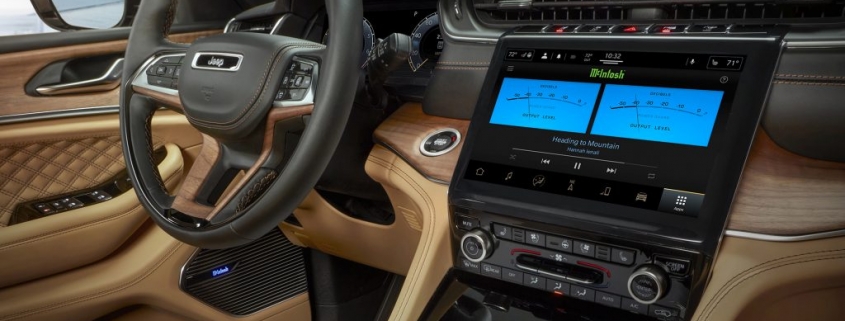2021 Chicago Auto Show: How McIntosh Audio Found a Home in Jeep
Cars are no strangers to high-end audio and stereo systems, especially luxury cars. But some systems are more exclusive than others. Case in point, the new McIntosh audio systems found in a select few Jeep SUVs. However, while the McIntosh brand is well-known to home audio listeners, how well does its engineering translate to the automotive realm? Especially in off-road SUVs? To answer these questions and more, MotorBiscuit sat down with McIntosh’s CEO, Jeff Poggi, at the 2021 Chicago Auto Show.
What McIntosh audio systems are available to Jeep SUV buyers?
Jeep offers two different McIntosh audio systems for three of its 2021 and 2022 SUVs.
The first audio option is the McIntosh MX950 Entertainment System. It’s a 950W system with a 17-channel Class-D amplifier and 19 speakers spread amongst 12 locations. There are seven coaxial speakers—three in the front dash, two in the second row, and two in the rear—with a 3.5” midrange woofer and a 1” tweeter. Each front door has two 6” x 9” woofers, while the rear cargo area houses a 10” dual-voice coil subwoofer.
To prevent occupants from dropping the bass so hard the audio distorts, the MX950 system comes with McIntosh’s patented Power Guard circuit. And it comes with McIntosh’s iconic blue-lit power meters. Also, the speakers feature another brand trademark: its LD/HP (Low Distortion/High Performance) speakers.

The McIntosh MX950 audio system is available in the 2021 Jeep Grand Cherokee L’s and the 2022 Wagoneer’s higher trims. It’s optional in the Grand Cherokee L Overland and Summit trims and standard on Summit Reserve models. In the Wagoneer’s case, you’ll have to step up to the range-topping Series III.
Buyers can also get the MX950 on the 2022 Grand Wagoneer Series I and II. However, the Grand Wagoneer Obsidian and Series III trims come with something else: the MX1375 Reference System. Audiophiles are likely familiar with that term, as it’s what McIntosh calls its flagship home audio system.
The MX1375 system gets several upgrades over the MX950. It has a 1375W, 24-channel amplifier driving 23 speakers spread out over 16 locations. Of those 23 speakers, 19 are identical in spec and arrangement to the MX950’s speakers. However, McIntosh gives the MX1375 audio system four additional in-ceiling 2” speakers. And on top of the blue-lit meters, LD/HP speakers, and Power Guard, the MX1375 also gets something called ‘Adaptive 3D Surround Processing.’ But more on that later.
We talk audio with McIntosh CEO Jeff Poggi at the 2021 Chicago Auto Show
Although the MX1375 is the brand’s first automotive Reference System, it’s not the first McIntosh car audio setup. Founded in 1949, McIntosh first got into cars in the ‘90s, building amplifiers and stereo head units. And the first car with a true McIntosh OEM audio system was the Subaru Legacy. Plus, the Binghamton, NY-based brand’s systems have also appeared on Harleys and in the 2005-2006 Ford GT. However, McIntosh exited the car audio segment after that—until now.
Talking with brand CEO Jeff Poggi at the 2021 Chicago Auto Show, it’s clear that this wasn’t a simple marketing move. Nor was it made out of necessity. “We’re not actively looking for other [automotive] partners,” Poggi says. For now, the MX1375 and MX950 will be McIntosh’s only car systems, barring any “special and unique situation,” he adds.
As for why McIntosh worked with Jeep, Poggi says the “brands fit very, very well together: American brands, long histories, reliability, durability, passion…enthusiastic fans.” And this partnership was a true collaboration with Jeep’s designers. “We [McIntosh] were in [Jeep’s] design lab all the time,” Poggi explains, with “products…so that they could understand our design language [and] our brand.” Poggi also complimented the designers for sweating the details, including making the control knobs resemble McIntosh’s own controls.
Bigger rooms and goosebumps: putting home audio quality into a car
But McIntosh put in plenty of effort on its end, too.
A car’s interior is not an ideal acoustic space. “You’re in a much smaller room,” Poggi explains, “a large closet.” He adds, “The car consists of a bunch of reflective surfaces, like the hard plastics and the glass, as well as absorptive surfaces like the carpets and the seats. And that all affects the sound quality.”
Also, unlike in a home setting, the listener isn’t sitting directly in the middle. Not only do cars have multiple seating positions, but they leave the driver and passengers sitting askew from the speakers. And that’s all without ambient road and wind noise.
Those are a lot of factors and complications to consider when designing an automotive audio system. But McIntosh decided to tackle it anyway. Five years ago, the company released a proof-of-concept design. This ‘demo’ was put in a Jeep Grand Cherokee and later presented to head designer Ralph Gilles and then-CEO Sergio Marchionne. And when the two heard how well the car system matched the home audio system, McIntosh got the go-ahead for the collaboration.
Creating that ‘demo’ let the team understand things like “the room acoustics of the car, where do the woofers need to go, where do the midranges need to go, where do the tweeters need to go, how many of them do you need in order to get the proper…acoustic attributes,” Poggi explains. That’s why McIntosh was so involved with the SUVs’ interior design: even things like the headliner and wood trim affect the sound quality. It’s also why the MX1375 has that Adaptive 3D Surround Processing feature, Poggi says. It helps make sure the SUV doesn’t “just sound good statically—because people are going to be driving it actively.” That includes a measure of active noise cancellation.
However, while McIntosh used objective audio measurements and specifications during the design process, they were only part of the equation. In the end, Poggi emphasizes, the company’s main goal is, “Does it give you goosebumps? Does it bring tears to your eyes?”
Is the system worth the money?

After talking with Poggi, I got an audio quality demonstration in a 2022 Grand Wagoneer equipped with the McIntosh MX1375. Getting this system in the SUV isn’t cheap; before destination, the Grand Wagoneer Obsidian starts at $99,590. Though that’s to be expected, given that even an ‘affordable’ McIntosh preamplifier costs $7K, Gear Patrol reports. And the home Reference System easily stretches past $200K.
Admittedly, I haven’t sampled many high-end audio systems, whether in cars or at home. It’s therefore tough to tell if the MX1375 is better than, say, a Mercedes-Benz Burmester system. And the Grand Wagoneer at the Chicago Auto Show was a pre-production, stationary model, so on-road results may vary.
All that being said, the MX1375 sounds incredible. Notes are crisp and textured, while the speaker tones are rich and resonant. You can hear drums pass from one corner of the room to the other. And even with an incredibly bass-heavy song, nothing shakes or rattles. Plus, credit to the McIntosh team, the Grand Wagoneer’s interior genuinely feels larger in your ears. Though perhaps that shouldn’t be surprising, given that McIntosh designed the Grateful Dead’s ‘Wall of Sound,’ Roadshow notes.
In short, Jeep-owning audiophiles, you have nothing to worry about. The McIntosh systems live up to the company’s standards.
Follow more updates from MotorBiscuit on our Facebook page.
RELATED: The New Jeep Grand Wagoneer Is a Real American Range Rover
The post 2021 Chicago Auto Show: How McIntosh Audio Found a Home in Jeep appeared first on MotorBiscuit.







